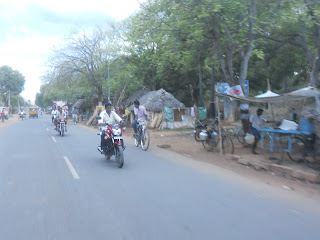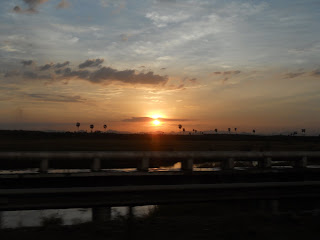
observing the cooking being done for the school children. all very sanitary. no transmission of diarrheal disease here. and the lunch ladies were awesome.

hanging out with the lunch ladies in the kitchen. those big pots are full of rice and sambar (veggie soup to put over the rice. delicious, but kicks my esophagus's butt).

home visit with mother and her 2 and a half year old daughter.

cow hanging out in the busy road. im worried about an inevitable crash with me and motor vehicle, but if the cow can stay alive, maybe there's hope for me and my supposedly more evolved brain yet.

hanging out at school with Subha, one of the ICTPH community health workers who helps us get around town with her expertise of the village.

put the condensed milk and the sugar in the coffee and mix it all together...

coffee making

the school we visited

"money is the root of all evil" is written on the board in this English classroom

monkeys climbing up to our food stash. they broke the water pipe the other day doing so. while i was in the shower. covered in soap. cant make this stuff up.
Woo-hoo, almost finished with our first draft of our intervention plan. Minus the actual intervention...
It seems that every time we go into the field (almost every day this week) we see another aspect of diarrheal disease and a new perspective from different community members. While we are moving closer to narrowing down a specific intervention, we seem to be moving farther away from our original understanding of the issue. In a good way--more pieces of the puzzle are revealing themselves. Still questions on how to fit them all together and which pieces should be weighted more than others, though.
We spent time talking to the village panchayat (village president, like a mayor in the US), a primary health center nurse (nurse from the government run primary health care clinic), parents with young children experiencing diarrheal disease and a school headmistress and the school cooks who prepare lunch for the children.
A few really interesting things:
-the nurse reported that water in the government tanks is chlorinated at the time of cleaning, which is every few months. Furthermore, she reported that two tablets are used for the tank. Two tablets is the appropriate amount for two liters of water, for a 24 hour period. The tank holds tens to hundreds of thousands of liters of water, and is chlorinated every few months. She also reported that the water filling the tank is clean, as it is coming from an underground source that is safe. We are planning on testing the water in the tank on Sunday with the panchayat to see what it really looks like.
-some village residents reported that they are not happy with the water, and suspect that it's possible the water is playing a role in their children's diarrheal disease. They also said that they would need a large scale movement among the village residents to move the panchayat. They didn't think this was viable because many people are happy with the water or even take matters into their own hands (some people break the underground pipes that lead to the taps in order to pipe "clean" water to their own homes...however, this pipe breaking opens more opportunity for water contamination).
-one mother reported taking her young daughter to the doctor several times a year because of diarrhea. The mother reported spending 500 rupees on each visit. That's a lot of money (about $10 US)...makes me wonder if this family is one of the families who reported taking out loans to pay for medical expenses. Despite paying this large fee, the mother reported that the doctor has not once given her daughter ORS treatment...
So, again, there are a few things going on: problems at the government level in terms of politics and policy for supplying clean water, problems at the private practice level (the mother above went to a private provider), problems going on at the community level (people breaking pipes to make their own taps), problems at the household level (people aren't boiling their water or treating it in any other way)...just to name a few...
What was really hard (and yes, I know, this is going to be like one of those save the children announcements, full of feelings and stuff that I generally avoid talking about, but it must be said) was just hanging out with the mom mentioned above and her daughter, knowing that this little girl was sick as a result of preventable disease. She just happened to be born into a place where the conditions allow for diarrheal disease to be prevalent...and according to the research out there, her whole life could potentially be negatively impacted because of her chronic illness. Children who suffer from chronic diarrhea before two years of age have been shown to have impaired cognitive functioning compared to healthy children. In addition, nutritional status is often poor in children who have continuous diarrhea, which is associated with a whole bunch of bad stuff like stunting and wasting. And, in terms of economics and future economic potential, the family's resources are strained when they are constantly taking kids to the doctor, which might influence what opportunities will later be available for school, or social development or starting a business, etc. Bad, bad, bad.
Certainly an incentive to stay on top of our game as we continue to move closer to proposing an intervention...maybe we could actually prevent some of this stuff from happening in the future...
So, yes, on that note...other life happenings.
Foremost, food:
-monkeys everywhere! they have moved on from taking fruit to Nutella and Digestives. Sneaky little bastards.
-we had the most amazing chick pea curry the other night. I can't wait to observe this family who cooks for us. How do they make such wonderful things? Probably helps all the food is local, fresh and naturally organic...
-also, paneer butter masala...mmmmmm. My go to dish on our usual visits to Hotel Sangum's restaurant. Ravi, our co-instructor, and his wife have promised to show us how it's done. I cannot wait!!
-I drank my third cup of coffee ever. It tasted good! Because it was essentially condensed milk and sugar. And the woman who made it was awesome-- she owns one of the other coffee shops in the village where we are doing our field work.
-we visited Arun ice cream shop. So many flavors! And toppings! I was lame and stuck to chocolate stuff, but next visit will include some of the local fruit flavors like guava, jackfruit and lychee.
Other things non-food related (yes food is my first filter for organizing my thoughts):
-GIS (geographic information systems) mapping is awesome. With Ravi's help, we have a nice map of the water tanks, taps, schools and public toilets coming along. From there we can see who where some of the determinants of diarrheal disease are hanging out, who has access to what and is interacting with the determinants where, where good locations would be for point of access filtration...so cool!!
-One of the schools we visited had "money is the root of all evil" written on the board. Interesting phrase to be teaching, huh?
-I still get a kick out of cows hanging out in the middle of (very) busy roads.
-How about the London School of Hygiene and Tropical Medicine...eh? I'm kicking myself for not staying on the public health track after college...life gets in the way, I guess. Perhaps now would be a good time to re-explore that path...meep!
Thus, recent life happenings in a (rather disorganized) bullet-pointed outline.






 observing the cooking being done for the school children. all very sanitary. no transmission of diarrheal disease here. and the lunch ladies were awesome.
observing the cooking being done for the school children. all very sanitary. no transmission of diarrheal disease here. and the lunch ladies were awesome. hanging out with the lunch ladies in the kitchen. those big pots are full of rice and sambar (veggie soup to put over the rice. delicious, but kicks my esophagus's butt).
hanging out with the lunch ladies in the kitchen. those big pots are full of rice and sambar (veggie soup to put over the rice. delicious, but kicks my esophagus's butt). home visit with mother and her 2 and a half year old daughter.
home visit with mother and her 2 and a half year old daughter. cow hanging out in the busy road. im worried about an inevitable crash with me and motor vehicle, but if the cow can stay alive, maybe there's hope for me and my supposedly more evolved brain yet.
cow hanging out in the busy road. im worried about an inevitable crash with me and motor vehicle, but if the cow can stay alive, maybe there's hope for me and my supposedly more evolved brain yet. hanging out at school with Subha, one of the ICTPH community health workers who helps us get around town with her expertise of the village.
hanging out at school with Subha, one of the ICTPH community health workers who helps us get around town with her expertise of the village. put the condensed milk and the sugar in the coffee and mix it all together...
put the condensed milk and the sugar in the coffee and mix it all together... coffee making
coffee making the school we visited
the school we visited "money is the root of all evil" is written on the board in this English classroom
"money is the root of all evil" is written on the board in this English classroom monkeys climbing up to our food stash. they broke the water pipe the other day doing so. while i was in the shower. covered in soap. cant make this stuff up.
monkeys climbing up to our food stash. they broke the water pipe the other day doing so. while i was in the shower. covered in soap. cant make this stuff up. 

 fresh coffee after a day in the field
fresh coffee after a day in the field one of the community health worker's coffee shops
one of the community health worker's coffee shops some peace
some peace hand washing stations at the school
hand washing stations at the school the school
the school government water tank
government water tank girls getting water out of one of the taps
girls getting water out of one of the taps rice fields on the way to Ambalapattu
rice fields on the way to Ambalapattu the autos lined up to take us out for Dessas birthday dinner
the autos lined up to take us out for Dessas birthday dinner sometimes elephants walk down the side of the road
sometimes elephants walk down the side of the road




 Kingfisher Blue?
Kingfisher Blue?
 Mmmmm...beach...
Mmmmm...beach...
 Lunch!
Lunch!
 Saw lots of these chalk drawings on doorsteps for homes and businesses
Saw lots of these chalk drawings on doorsteps for homes and businesses European feel
European feel Mediterranean feel
Mediterranean feel A Tree Grows in Brooklyn...or over the open sewer in Pondi...
A Tree Grows in Brooklyn...or over the open sewer in Pondi... One of the beaches we visited with sand
One of the beaches we visited with sand The new lighthouse
The new lighthouse







